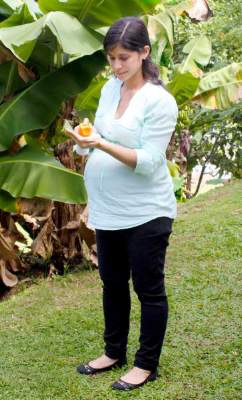User login
More pregnant women in the United States and its territories may be at risk for Zika virus–related birth complications than previously reported, according to the Centers for Disease Control and Prevention.
As of May 12, CDC officials were monitoring 279 pregnant women with laboratory evidence of possible Zika virus infection – 157 in U.S. states and 122 in U.S. territories, according to a report published in the Morbidity and Mortality Weekly Report (2016 May 20. doi: 10.15585/mmwr.mm6520e1).
“We’ve learned a lot in the last 4 months, and now we know of reports of asymptomatic Zika infections linked to microcephaly, brain defects, and miscarriage,” Margaret Honein, Ph.D., chief of the birth defects branch at the CDC’s National Center for Birth Defects and Developmental Disabilities, said during a May 20 media briefing to announce enhanced tracking of the virus.
Recently published data indicating congenital defects in children born to mothers who had no recollection of ever having Zika-like symptoms spurred the CDC to widen its scope of data capture, Dr. Honein said.
Since February 2016, the CDC has been relying on data from the national arboviral disease surveillance system (ArboNET) to track Zika in pregnant women with symptoms of the Zika virus infection, or those with pregnancy complications consistent with the virus. Although ArboNET describes a subset of pregnancies at risk from Zika virus, it does not track actual congenital outcomes.
Now, federal health officials have created two registries solely dedicated to collecting data on birth outcomes among both symptomatic and asymptomatic women with any laboratory evidence of Zika virus infections. In the continental United States, there is the U.S. Zika Pregnancy Registry (USZPR). In Puerto Rico, there is the Zika Active Pregnancy Surveillance System (ZAPSS).
The 279 pregnant women currently being monitored reflect a broader group of pregnant women than numbers previously reported since it includes pregnant women who have any laboratory evidence of possible Zika virus infection, regardless of them being asymptomatic or whether they recalled ever having symptoms.
New figures on Zika infection in pregnancy will be posted on the CDC website each Thursday at noon EDT, and will reflect the previous week’s numbers.
“This reporting is in line with our recommendations for ongoing monitoring of pregnancies at risk for poor outcomes associated with Zika, based on our current understanding [of the virus],” Dr. Honein said. She recommended that pregnant women be tested for the virus at the start of prenatal care and again during the third trimester.The registry data will be used to determine those most at risk, characterize adverse Zika-related outcomes, and help officials plan for services needed by affected families, said Dr. Honein, encouraging all jurisdictions covered by the surveillance systems to participate in the data collection as quickly as possible.
Meanwhile, Dr. Honein said that the CDC is withholding specific information on known adverse birth outcomes in order to respect the affected families’ privacy, but did say that as of May 20, the CDC was aware of “less than a dozen adverse outcomes, including miscarriages and birth defects.”
Dr. Honein also declined to say how many of the cases reported to the registry involve sexual transmission of the virus versus actual contact with the Aedes aegypti mosquito.
On Twitter @whitneymcknight
More pregnant women in the United States and its territories may be at risk for Zika virus–related birth complications than previously reported, according to the Centers for Disease Control and Prevention.
As of May 12, CDC officials were monitoring 279 pregnant women with laboratory evidence of possible Zika virus infection – 157 in U.S. states and 122 in U.S. territories, according to a report published in the Morbidity and Mortality Weekly Report (2016 May 20. doi: 10.15585/mmwr.mm6520e1).
“We’ve learned a lot in the last 4 months, and now we know of reports of asymptomatic Zika infections linked to microcephaly, brain defects, and miscarriage,” Margaret Honein, Ph.D., chief of the birth defects branch at the CDC’s National Center for Birth Defects and Developmental Disabilities, said during a May 20 media briefing to announce enhanced tracking of the virus.
Recently published data indicating congenital defects in children born to mothers who had no recollection of ever having Zika-like symptoms spurred the CDC to widen its scope of data capture, Dr. Honein said.
Since February 2016, the CDC has been relying on data from the national arboviral disease surveillance system (ArboNET) to track Zika in pregnant women with symptoms of the Zika virus infection, or those with pregnancy complications consistent with the virus. Although ArboNET describes a subset of pregnancies at risk from Zika virus, it does not track actual congenital outcomes.
Now, federal health officials have created two registries solely dedicated to collecting data on birth outcomes among both symptomatic and asymptomatic women with any laboratory evidence of Zika virus infections. In the continental United States, there is the U.S. Zika Pregnancy Registry (USZPR). In Puerto Rico, there is the Zika Active Pregnancy Surveillance System (ZAPSS).
The 279 pregnant women currently being monitored reflect a broader group of pregnant women than numbers previously reported since it includes pregnant women who have any laboratory evidence of possible Zika virus infection, regardless of them being asymptomatic or whether they recalled ever having symptoms.
New figures on Zika infection in pregnancy will be posted on the CDC website each Thursday at noon EDT, and will reflect the previous week’s numbers.
“This reporting is in line with our recommendations for ongoing monitoring of pregnancies at risk for poor outcomes associated with Zika, based on our current understanding [of the virus],” Dr. Honein said. She recommended that pregnant women be tested for the virus at the start of prenatal care and again during the third trimester.The registry data will be used to determine those most at risk, characterize adverse Zika-related outcomes, and help officials plan for services needed by affected families, said Dr. Honein, encouraging all jurisdictions covered by the surveillance systems to participate in the data collection as quickly as possible.
Meanwhile, Dr. Honein said that the CDC is withholding specific information on known adverse birth outcomes in order to respect the affected families’ privacy, but did say that as of May 20, the CDC was aware of “less than a dozen adverse outcomes, including miscarriages and birth defects.”
Dr. Honein also declined to say how many of the cases reported to the registry involve sexual transmission of the virus versus actual contact with the Aedes aegypti mosquito.
On Twitter @whitneymcknight
More pregnant women in the United States and its territories may be at risk for Zika virus–related birth complications than previously reported, according to the Centers for Disease Control and Prevention.
As of May 12, CDC officials were monitoring 279 pregnant women with laboratory evidence of possible Zika virus infection – 157 in U.S. states and 122 in U.S. territories, according to a report published in the Morbidity and Mortality Weekly Report (2016 May 20. doi: 10.15585/mmwr.mm6520e1).
“We’ve learned a lot in the last 4 months, and now we know of reports of asymptomatic Zika infections linked to microcephaly, brain defects, and miscarriage,” Margaret Honein, Ph.D., chief of the birth defects branch at the CDC’s National Center for Birth Defects and Developmental Disabilities, said during a May 20 media briefing to announce enhanced tracking of the virus.
Recently published data indicating congenital defects in children born to mothers who had no recollection of ever having Zika-like symptoms spurred the CDC to widen its scope of data capture, Dr. Honein said.
Since February 2016, the CDC has been relying on data from the national arboviral disease surveillance system (ArboNET) to track Zika in pregnant women with symptoms of the Zika virus infection, or those with pregnancy complications consistent with the virus. Although ArboNET describes a subset of pregnancies at risk from Zika virus, it does not track actual congenital outcomes.
Now, federal health officials have created two registries solely dedicated to collecting data on birth outcomes among both symptomatic and asymptomatic women with any laboratory evidence of Zika virus infections. In the continental United States, there is the U.S. Zika Pregnancy Registry (USZPR). In Puerto Rico, there is the Zika Active Pregnancy Surveillance System (ZAPSS).
The 279 pregnant women currently being monitored reflect a broader group of pregnant women than numbers previously reported since it includes pregnant women who have any laboratory evidence of possible Zika virus infection, regardless of them being asymptomatic or whether they recalled ever having symptoms.
New figures on Zika infection in pregnancy will be posted on the CDC website each Thursday at noon EDT, and will reflect the previous week’s numbers.
“This reporting is in line with our recommendations for ongoing monitoring of pregnancies at risk for poor outcomes associated with Zika, based on our current understanding [of the virus],” Dr. Honein said. She recommended that pregnant women be tested for the virus at the start of prenatal care and again during the third trimester.The registry data will be used to determine those most at risk, characterize adverse Zika-related outcomes, and help officials plan for services needed by affected families, said Dr. Honein, encouraging all jurisdictions covered by the surveillance systems to participate in the data collection as quickly as possible.
Meanwhile, Dr. Honein said that the CDC is withholding specific information on known adverse birth outcomes in order to respect the affected families’ privacy, but did say that as of May 20, the CDC was aware of “less than a dozen adverse outcomes, including miscarriages and birth defects.”
Dr. Honein also declined to say how many of the cases reported to the registry involve sexual transmission of the virus versus actual contact with the Aedes aegypti mosquito.
On Twitter @whitneymcknight

